2017 KIA SEDONA flasher
[x] Cancel search: flasherPage 15 of 586

INSTRUMENT PANEL OVERVIEW
25
Your vehicle at a glance
1. Audio remote control buttons ............4-209
2. Driver’s front air bag ............................3-73
3. Horn.....................................................4-70
4. Instrument cluster ................................4-82
5. Wiper and washer control lever .........4-138
6. Ignition switch ........................................5-6Engine START/STOP button .................5-9
7. Cruise control button ...........................5-46 Smart cruise control button .................5-50
8. Audio .................................................4-206
9. Hazard warning flasher .........................6-2
10. Climate control system.........4-146, 4-162
11. Shift lever...........................................5-13
12. Seat warmer ....................................4-190 Seat cooler ......................................4-191
13. Steering wheel warmer ON/OFF Button .................................4-69
14. Active ECO button .............................5-66 Drive mode button .............................5-67
15. Parking assist system ON/OFF button ................................4-125
16. 360° Camera monitoring system ON/OFF button ................................4-130
17. Center console storage box ............4-187
18. Sunglasses holder ...........................4-188
19. USB charger ....................................4-195
20. Power outlet.....................................4-192
21. AC inverter ......................................4-193
22. Glove box ........................................4-188
23. Passenger's front air bag ..................3-73
OYP016004N
❈ The actual instrument panel in the vehicle may differ from the illustration
Page 145 of 586
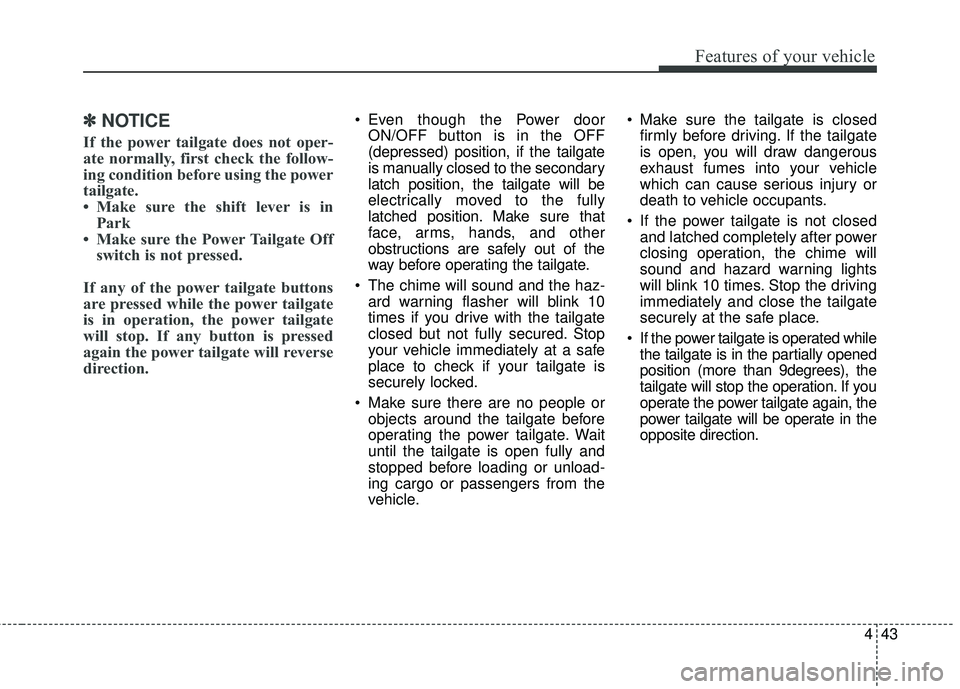
443
Features of your vehicle
✽ ✽NOTICE
If the power tailgate does not oper-
ate normally, first check the follow-
ing condition before using the power
tailgate.
• Make sure the shift lever is in
Park
• Make sure the Power Tailgate Off switch is not pressed.
If any of the power tailgate buttons
are pressed while the power tailgate
is in operation, the power tailgate
will stop. If any button is pressed
again the power tailgate will reverse
direction.
Even though the Power door ON/OFF button is in the OFF
(depressed) position, if the tailgate
is manually closed to the secondary
latch position, the tailgate will be
electrically moved to the fully
latched position. Make sure that
face, arms, hands, and other
obstructions are safely out of the
way before operating the tailgate.
The chime will sound and the haz- ard warning flasher will blink 10
times if you drive with the tailgate
closed but not fully secured. Stop
your vehicle immediately at a safe
place to check if your tailgate is
securely locked.
Make sure there are no people or objects around the tailgate before
operating the power tailgate. Wait
until the tailgate is open fully and
stopped before loading or unload-
ing cargo or passengers from the
vehicle. Make sure the tailgate is closed
firmly before driving. If the tailgate
is open, you will draw dangerous
exhaust fumes into your vehicle
which can cause serious injury or
death to vehicle occupants.
If the power tailgate is not closed and latched completely after power
closing operation, the chime will
sound and hazard warning lights
will blink 10 times. Stop the driving
immediately and close the tailgate
securely at the safe place.
If the power tailgate is operated while the tailgate is in the partially opened
position (more than 9degrees), the
tailgate will stop the operation. If you
operate the power tailgate again, the
power tailgate will be operate in the
opposite direction.
Page 423 of 586

579
Driving your vehicle
Warning indicator
When the LDWS is not working prop-
erly, the warning light will illuminate
and the warning message will come
on for a few second. After the mes-
sage disappears, the master warning
light will illuminate.Take your vehicle to an authorized
Kia dealer and have the system
checked.
The LDWS does not operate
when:
The driver turns on the turn signal
or the hazard warning flasher to
change lane.
Driving on the lane line.
✽ ✽ NOTICE
To change lanes, operate the turn
signal switch then change the lane.
The LDWS may not warn you
even if the vehicle leaves the
lane, or may warn you even if
the vehicle does not leave the
lane when;
The lane can't be visible due to
snow, rain, stain, a puddle or other
environmental conditions.
The brightness of the outside changes suddenly such as tunnel
enter/exit.
The headlights are off at night or in a tunnel.
The color of the lane marking from the road is difficult to distinguish.
Driving on a steep grade or a curve.
Light such as street light, sunlight or oncoming vehicle light reflects
from water on the road.
The lens or windshield is stained with foreign matter.
The sensor cannot detect the lane because of fog, heavy rain or
heavy snow.
OYP054114N
OYP054119K
■Warning message
■Master warning light
WARNING - LDWS
Limitations
The Lane Departure Warning
System is a supplemental sys-
tem. Do not solely rely on the
system but always pay attention
and drive safely.
Page 438 of 586
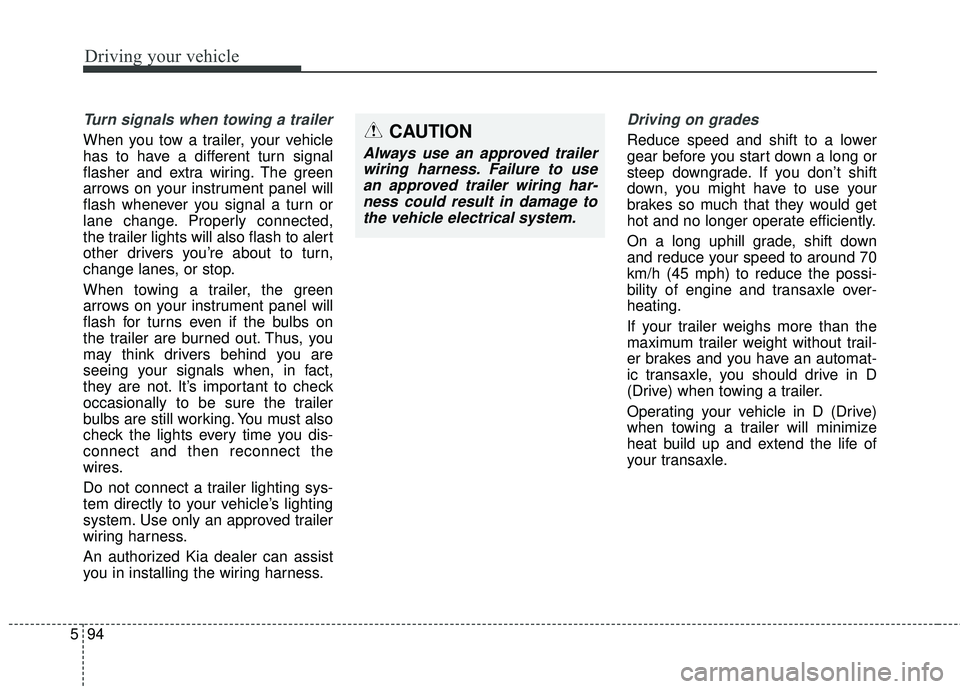
Driving your vehicle
94
5
Turn signals when towing a trailer
When you tow a trailer, your vehicle
has to have a different turn signal
flasher and extra wiring. The green
arrows on your instrument panel will
flash whenever you signal a turn or
lane change. Properly connected,
the trailer lights will also flash to alert
other drivers you’re about to turn,
change lanes, or stop.
When towing a trailer, the green
arrows on your instrument panel will
flash for turns even if the bulbs on
the trailer are burned out. Thus, you
may think drivers behind you are
seeing your signals when, in fact,
they are not. It’s important to check
occasionally to be sure the trailer
bulbs are still working. You must also
check the lights every time you dis-
connect and then reconnect the
wires.
Do not connect a trailer lighting sys-
tem directly to your vehicle’s lighting
system. Use only an approved trailer
wiring harness.
An authorized Kia dealer can assist
you in installing the wiring harness.
Driving on grades
Reduce speed and shift to a lower
gear before you start down a long or
steep downgrade. If you don’t shift
down, you might have to use your
brakes so much that they would get
hot and no longer operate efficiently.
On a long uphill grade, shift down
and reduce your speed to around 70
km/h (45 mph) to reduce the possi-
bility of engine and transaxle over-
heating.
If your trailer weighs more than the
maximum trailer weight without trail-
er brakes and you have an automat-
ic transaxle, you should drive in D
(Drive) when towing a trailer.
Operating your vehicle in D (Drive)
when towing a trailer will minimize
heat build up and extend the life of
your transaxle.CAUTION
Always use an approved trailer
wiring harness. Failure to usean approved trailer wiring har-ness could result in damage tothe vehicle electrical system.
Page 450 of 586
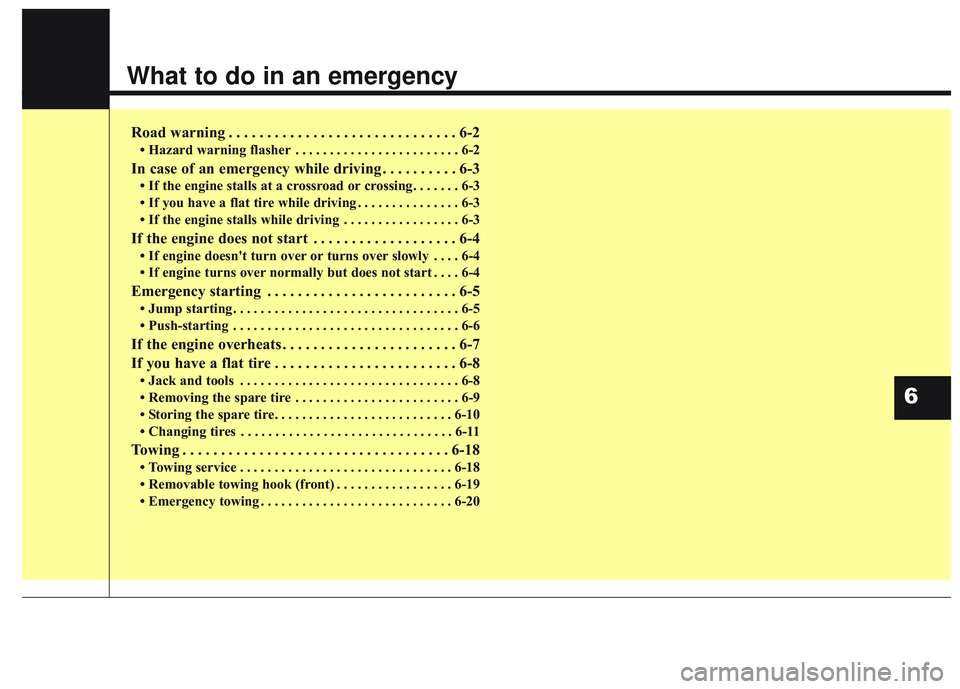
What to do in an emergency
Road warning . . . . . . . . . . . . . . . . . . . . . . . . . . . . . . 6-2
• Hazard warning flasher . . . . . . . . . . . . . . . . . . . . . . . . 6-2
In case of an emergency while driving . . . . . . . . . . 6-3
• If the engine stalls at a crossroad or crossing. . . . . . . 6-3
• If you have a flat tire while driving . . . . . . . . . . . . . . . 6-3
• If the engine stalls while driving . . . . . . . . . . . . . . . . . 6-3
If the engine does not start . . . . . . . . . . . . . . . . . . . 6-4
• If engine doesn't turn over or turns over slowly . . . . 6-4
• If engine turns over normally but does not start . . . . 6-4
Emergency starting . . . . . . . . . . . . . . . . . . . . . . . . . 6-5
• Jump starting . . . . . . . . . . . . . . . . . . . . . . . . . . . . . . . . . 6-5
• Push-starting . . . . . . . . . . . . . . . . . . . . . . . . . . . . . . . . . 6-6
If the engine overheats . . . . . . . . . . . . . . . . . . . . . . . 6-7
If you have a flat tire . . . . . . . . . . . . . . . . . . . . . . . . 6-8
• Jack and tools . . . . . . . . . . . . . . . . . . . . . . . . . . . . . . . . 6-8
• Removing the spare tire . . . . . . . . . . . . . . . . . . . . . . . . 6-9
• Storing the spare tire. . . . . . . . . . . . . . . . . . . . . . . . . . 6-10
• Changing tires . . . . . . . . . . . . . . . . . . . . . . . . . . . . . . . 6-11
Towing . . . . . . . . . . . . . . . . . . . . . . . . . . . . . . . . . . . 6-\
18
• Towing service . . . . . . . . . . . . . . . . . . . . . . . . . . . . . . . 6-18
• Removable towing hook (front) . . . . . . . . . . . . . . . . . 6-19
• Emergency towing . . . . . . . . . . . . . . . . . . . . . . . . . . . . 6-20
6
Page 451 of 586
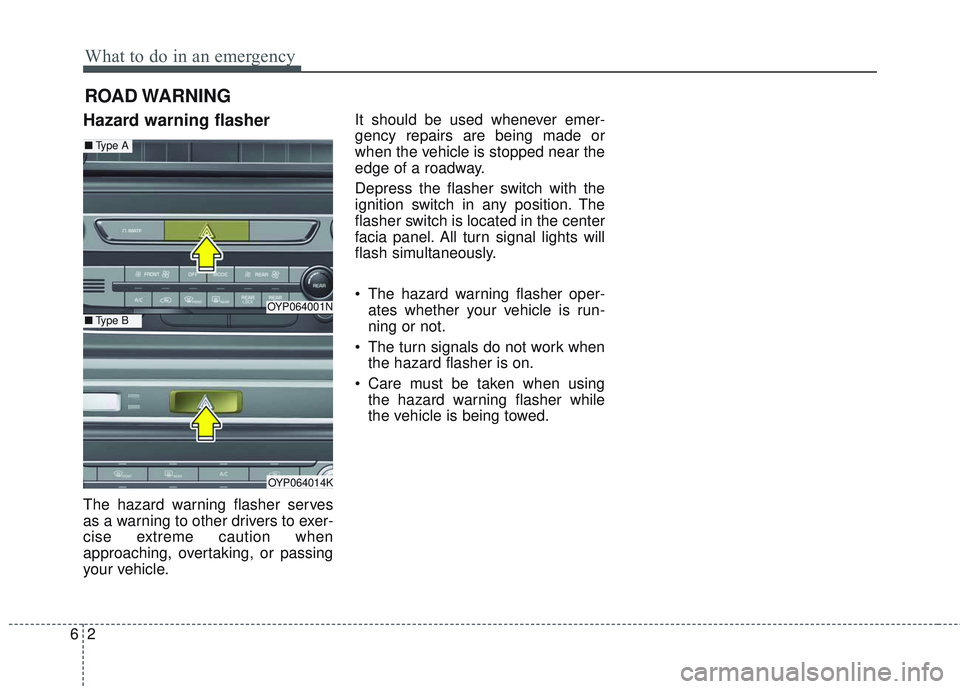
What to do in an emergency
26
ROAD WARNING
Hazard warning flasher
The hazard warning flasher serves
as a warning to other drivers to exer-
cise extreme caution when
approaching, overtaking, or passing
your vehicle.It should be used whenever emer-
gency repairs are being made or
when the vehicle is stopped near the
edge of a roadway.
Depress the flasher switch with the
ignition switch in any position. The
flasher switch is located in the center
facia panel. All turn signal lights will
flash simultaneously.
• The hazard warning flasher oper-
ates whether your vehicle is run-
ning or not.
The turn signals do not work when the hazard flasher is on.
Care must be taken when using the hazard warning flasher while
the vehicle is being towed.
OYP064001N
OYP064014K
■ Type A
■Type B
Page 452 of 586

63
What to do in an emergency
If the engine stalls at a cross-
road or crossing
If the engine stalls at a crossroad or
crossing, set the shift lever in the N
(Neutral) position and then push the
vehicle to a safe place.
If you have a flat tire while
driving
If a tire goes flat while you are driv-
ing:
1.Take your foot off the acceleratorpedal and let the vehicle slow
down while driving straight ahead.
Do not apply the brakes immedi-
ately or attempt to pull off the road
as this may cause a loss of control.
When the vehicle has slowed to
such a speed that it is safe to do
so, brake carefully and pull off the
road. Drive off the road as far as
possible and park on a firm level
ground. If you are on a divided
highway, do not park in the median
area between the two traffic lanes. 2.When the vehicle is stopped, turn
on your emergency hazard flash-
ers, set the parking brake and put
the transaxle in P (Park).
3.Have all passengers get out of the vehicle. Be sure they all get out on
the side of the vehicle that is away
from traffic.
4.When changing a flat tire, follow the instruction provided later in this
section.
If the engine stalls while driv-
ing
1.Reduce your speed gradually,keeping a straight line. Move cau-
tiously off the road to a safe place.
2.Turn on your emergency flashers.
3.Try to start the engine again. If your vehicle will not start, contact an
authorized Kia dealer or seek other
qualified assistance.
✽ ✽ NOTICE
If there was a check engine light and
loss of power or stall and if safe to do
so to wait at least 10 seconds to
restart the vehicle after it stalls. This
may reset the car so it will no longer
run at low power (limp home) condi-
tion.
IN CASE OF AN EMERGENCY WHILE DRIVING
Page 583 of 586
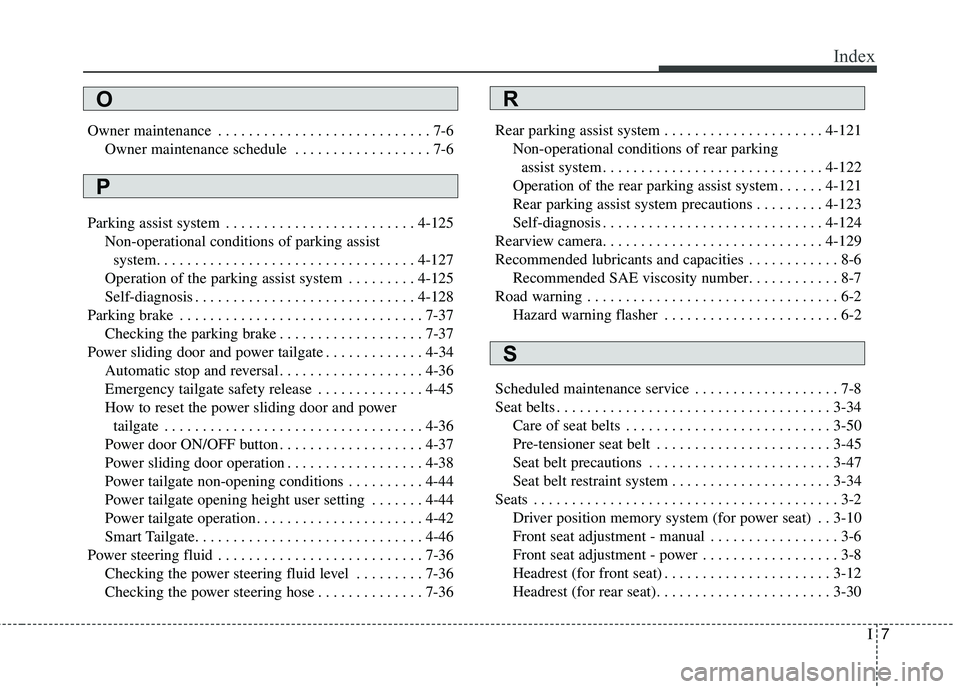
I7
Index
Owner maintenance . . . . . . . . . . . . . . . . . . . . . . . . . . . . 7-6Owner maintenance schedule . . . . . . . . . . . . . . . . . . 7-6
Parking assist system . . . . . . . . . . . . . . . . . . . . . . . . . 4-125 Non-operational conditions of parking assistsystem. . . . . . . . . . . . . . . . . . . . . . . . . . . . . . . . . . 4-12\
7
Operation of the parking assist system . . . . . . . . . 4-125
Self-diagnosis . . . . . . . . . . . . . . . . . . . . . . . . . . . . . 4-128
Parking brake . . . . . . . . . . . . . . . . . . . . . . . . . . . . . . . . 7-37 Checking the parking brake . . . . . . . . . . . . . . . . . . . 7-37
Power sliding door and power tailgate . . . . . . . . . . . . . 4-34 Automatic stop and reversal . . . . . . . . . . . . . . . . . . . 4-36
Emergency tailgate safety release . . . . . . . . . . . . . . 4-45
How to reset the power sliding door and powertailgate . . . . . . . . . . . . . . . . . . . . . . . . . . . . . . . . . . 4-36\
Power door ON/OFF button . . . . . . . . . . . . . . . . . . . 4-37
Power sliding door operation . . . . . . . . . . . . . . . . . . 4-38
Power tailgate non-opening conditions . . . . . . . . . . 4-44
Power tailgate opening height user setting . . . . . . . 4-44
Power tailgate operation . . . . . . . . . . . . . . . . . . . . . . 4-42
Smart Tailgate. . . . . . . . . . . . . . . . . . . . . . . . . . . . . . 4-46
Power steering fluid . . . . . . . . . . . . . . . . . . . . . . . . . . . 7-36 Checking the power steering fluid level . . . . . . . . . 7-36
Checking the power steering hose . . . . . . . . . . . . . . 7-36 Rear parking assist system . . . . . . . . . . . . . . . . . . . . . 4-121
Non-operational conditions of rear parkingassist system . . . . . . . . . . . . . . . . . . . . . . . . . . . . . 4-122
Operation of the rear parking assist system . . . . . . 4-121
Rear parking assist system precautions . . . . . . . . . 4-123
Self-diagnosis . . . . . . . . . . . . . . . . . . . . . . . . . . . . . 4-124
Rearview camera. . . . . . . . . . . . . . . . . . . . . . . . . . . . . 4-129
Recommended lubricants and capacities . . . . . . . . . . . . 8-6 Recommended SAE viscosity number. . . . . . . . . . . . 8-7
Road warning . . . . . . . . . . . . . . . . . . . . . . . . . . . . . . . . . 6-2 Hazard warning flasher . . . . . . . . . . . . . . . . . . . . . . . 6-2
Scheduled maintenance service . . . . . . . . . . . . . . . . . . . 7-8
Seat belts . . . . . . . . . . . . . . . . . . . . . . . . . . . . . . . . . . . . \
3-34 Care of seat belts . . . . . . . . . . . . . . . . . . . . . . . . . . . 3-50
Pre-tensioner seat belt . . . . . . . . . . . . . . . . . . . . . . . 3-45
Seat belt precautions . . . . . . . . . . . . . . . . . . . . . . . . 3-47
Seat belt restraint system . . . . . . . . . . . . . . . . . . . . . 3-34
Seats . . . . . . . . . . . . . . . . . . . . . . . . . . . . . . . . . . . . \
. . . . 3-2 Driver position memory system (for power seat) . . 3-10
Front seat adjustment - manual . . . . . . . . . . . . . . . . . 3-6
Front seat adjustment - power . . . . . . . . . . . . . . . . . . 3-8
Headrest (for front seat) . . . . . . . . . . . . . . . . . . . . . . 3-12
Headrest (for rear seat). . . . . . . . . . . . . . . . . . . . . . . 3-30
O
P
R
S